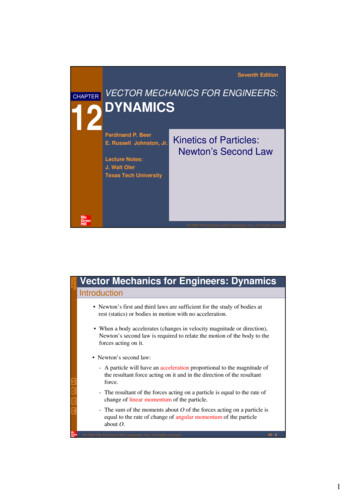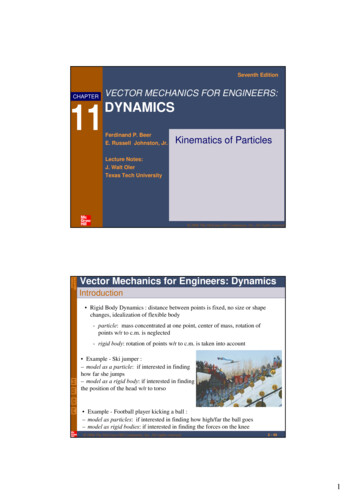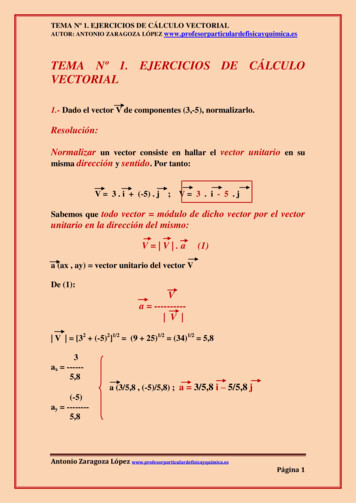
Transcription
Seventh EditionCHAPTER12VECTOR MECHANICS FOR ENGINEERS:DYNAMICSFerdinand P. BeerE. Russell Johnston, Jr.Kinetics of Particles:Newton’s Second LawLecture Notes:J. Walt OlerTexas Tech University 2003 The McGraw-Hill Companies, Inc. All rights reserved.SeventhEditionVector Mechanics for Engineers: DynamicsIntroduction Newton’s first and third laws are sufficient for the study of bodies atrest (statics) or bodies in motion with no acceleration. When a body accelerates (changes in velocity magnitude or direction),Newton’s second law is required to relate the motion of the body to theforces acting on it. Newton’s second law:- A particle will have an acceleration proportional to the magnitude ofthe resultant force acting on it and in the direction of the resultantforce.- The resultant of the forces acting on a particle is equal to the rate ofchange of linear momentum of the particle.- The sum of the moments about O of the forces acting on a particle isequal to the rate of change of angular momentum of the particleabout O. 2003 The McGraw-Hill Companies, Inc. All rights reserved.12 - 21
SeventhEditionVector Mechanics for Engineers: DynamicsNewton’s Second Law of Motion Newton’s second law (acceleration ): If the resultant force acting on a particle is not zero, theparticle will have an acceleration proportional to themagnitude of resultant and in the direction of the resultant.r When a particle of mass m is acted upon by a force F ,the acceleration of the particle must satisfyrrF ma Acceleration must be evaluated with respect to aNewtonian frame of reference, i.e., one that is notaccelerating or rotating. If force acting on particle is zero, particle will notaccelerate, i.e., it will remain stationary or continue on astraight line at constant velocity. 2003 The McGraw-Hill Companies, Inc. All rights reserved.12 - 3SeventhEditionVector Mechanics for Engineers: DynamicsDynamic Equilibrium Alternate expression of Newton’s second law,rr F ma 0r ma inertial vector With the inclusion of the inertial vector, the systemof forces acting on the particle is equivalent tozero. The particle is in dynamic equilibrium. Methods developed for particles in staticequilibrium may be applied, e.g., coplanar forcesmay be represented with a closed vector polygon. Inertia vectors are often called inertial forces asthey measure the resistance that particles offer tochanges in motion, i.e., changes in speed ordirection. Inertial forces may be conceptually useful but arenot like the contact and gravitational forces foundin statics. 2003 The McGraw-Hill Companies, Inc. All rights reserved.12 - 42
SeventhEditionVector Mechanics for Engineers: DynamicsLinear Momentum of a Particle Newton’s second law (linear momentum ):- The resultant of the forces acting on a particle is equal to the rate ofchange of linear momentum of the particle. Replacing the acceleration by the derivative of thevelocity yieldsrrdv F mdtrdr dL (m v ) dtdtrL linear momentum of the particle Linear Momentum Conservation Principle:If the resultant force on a particle is zero, the linearmomentum of the particle remains constant in bothmagnitude and direction. 2003 The McGraw-Hill Companies, Inc. All rights reserved.12 - 5SeventhEditionVector Mechanics for Engineers: DynamicsEquations of Motion Newton’s second law providesrr F ma Solution for particle motion is facilitated by resolvingvector equation into scalar component equations, e.g.,for rectangular components,rrrrrr (Fx i Fy j Fz k ) m(a x i a y j a z k ) Fx ma x Fy ma y Fz ma z Fx m&x& Fy m&y& Fz m&z& For tangential and normal components, F t mat Ft m 2003 The McGraw-Hill Companies, Inc. All rights reserved.dvdt F n man Fn mv2ρ12 - 63
SeventhEditionVector Mechanics for Engineers: DynamicsEquations of Motion For radial and transverse components, Fr mar m(&r& rθ& 2 ) Fθ maθ m(rθ&& 2r&θ& ) 2003 The McGraw-Hill Companies, Inc. All rights reserved.12 - 7SeventhEditionVector Mechanics for Engineers: DynamicsSample Problem 12.1SOLUTION: Resolve the equation of motion for theblock into two rectangular componentequations.A 200-lb block rests on a horizontalplane. Find the magnitude of the forceP required to give the block an acceleration or 10 ft/s2 to the right. The coefficient of kinetic friction between theblock and plane is µk 0.25. Unknowns consist of the applied forceP and the normal reaction N from theplane. The two equations may besolved for these unknowns. 2003 The McGraw-Hill Companies, Inc. All rights reserved.12 - 84
SeventhEditionVector Mechanics for Engineers: DynamicsSample Problem 12.1SOLUTION: Resolve the equation of motion for the blockinto two rectangular component equations. Fx ma :(O)(P cos 30 0.25 N 6.21 lb s 2 ft 10 ft s 2y) 62.1lb Fy 0 :xm W200 lb g 32.2 ft s 2lb s 2ftF µk N 6.21 0.25 NN P sin 30 200 lb 0 Unknowns consist of the applied force P andthe normal reaction N from the plane. The twoequations may be solved for these unknowns.N P sin 30 200 lbP cos 30 0.25( P sin 30 200 lb ) 62.1 lbP 151lb 2003 The McGraw-Hill Companies, Inc. All rights reserved.12 - 9SeventhEditionVector Mechanics for Engineers: DynamicsSample Problem 12.3SOLUTION: Write the kinematic relationships for thedependent motions and accelerations ofthe blocks. Write the equations of motion for theblocks and pulley. Combine the kinematic relationshipswith the equations of motion to solve forthe accelerations and cord tension.The two blocks shown start from rest.The horizontal plane and the pulley arefrictionless, and the pulley is assumedto be of negligible mass. Determinethe acceleration of each block and thetension in the cord. 2003 The McGraw-Hill Companies, Inc. All rights reserved.12 - 105
SeventhEditionVector Mechanics for Engineers: DynamicsSample Problem 12.3OxySOLUTION: Write the kinematic relationships for the dependentmotions and accelerations of the blocks.y B 12 x Aa B 12 a A Write equations of motion for blocks and pulley. Fx m A a A :T1 (100 kg )a A Fy m B a B :m B g T2 m B a B(300 kg )(9.81 m s 2 ) T2 (300 kg )a BT2 2940 N - (300 kg )a B Fy mC aC 0 :T2 2T1 0 2003 The McGraw-Hill Companies, Inc. All rights reserved.12 - 11SeventhEditionVector Mechanics for Engineers: DynamicsSample Problem 12.3 Combine kinematic relationships with equations ofmotion to solve for accelerations and cord tension.Oxyy B 12 x Aa B 12 a AT1 (100 kg )a AT2 2940 N - (300 kg )a B( 2940 N - (300 kg ) 12 a A)T2 2T1 02940 N (150 kg )a A 2(100 kg )a A 0a A 8.40 m s 2a B 12 a A 4.20 m s 2T1 (100 kg )a A 840 NT2 2T1 1680 N 2003 The McGraw-Hill Companies, Inc. All rights reserved.12 - 126
SeventhEditionVector Mechanics for Engineers: DynamicsSample Problem 12.4SOLUTION: The block is constrained to slide downthe wedge. Therefore, their motions aredependent. Express the acceleration ofblock as the acceleration of wedge plusthe acceleration of the block relative tothe wedge.The 12-lb block B starts from rest andslides on the 30-lb wedge A, which issupported by a horizontal surface. Write the equations of motion for thewedge and block. Solve for the accelerations.Neglecting friction, determine (a) theacceleration of the wedge, and (b) theacceleration of the block relative to thewedge. 2003 The McGraw-Hill Companies, Inc. All rights reserved.12 - 13SeventhEditionVector Mechanics for Engineers: DynamicsSample Problem 12.4SOLUTION: The block is constrained to slide down thewedge. Therefore, their motions are dependent.rrraB a A aB A Write equations of motion for wedge and block. Fx m A a A :N1 sin 30 m A a Ay0.5 N1 (W A g )a Ax Fx mB a x mB (a A cos 30 a B A ) : WB sin 30 (WB g )(a A cos 30 a BaBAA) a A cos 30 g sin 30 Fy mB a y mB ( a A sin 30 ) :N1 WB cos 30 (WB g )a A sin 30 2003 The McGraw-Hill Companies, Inc. All rights reserved.12 - 147
SeventhEditionVector Mechanics for Engineers: DynamicsSample Problem 12.4 Solve for the accelerations.0.5 N1 (W A g )a AN1 WB cos 30 (WB g )a A sin 30 2(W A g )a A WB cos 30 (WB g )a A sin 30 aA aA gWB cos 30 2W A WB sin 30 (32.2 ft s 2 )(12 lb)cos 30 2(30 lb ) (12 lb ) sin 30 a A 5.07 ft s 2aBA a A cos 30 g sin 30 aBA 5.07 ft s 2 cos 30 32.2 ft s 2 sin 30 ()(aB 2003 The McGraw-Hill Companies, Inc. All rights reserved.)A 20.5 ft s 212 - 15SeventhEditionVector Mechanics for Engineers: DynamicsSample Problem 12.5SOLUTION: Resolve the equation of motion for thebob into tangential and normalcomponents. Solve the component equations for thenormal and tangential accelerations.The bob of a 2-m pendulum describesan arc of a circle in a vertical plane. Ifthe tension in the cord is 2.5 times theweight of the bob for the positionshown, find the velocity and acceleration of the bob in that position. Solve for the velocity in terms of thenormal acceleration. 2003 The McGraw-Hill Companies, Inc. All rights reserved.12 - 168
SeventhEditionVector Mechanics for Engineers: DynamicsSample Problem 12.5SOLUTION: Resolve the equation of motion for the bob intotangential and normal components. Solve the component equations for the normal andtangential accelerations.mg sin 30 mat Ft mat :at g sin 30 Fn man :at 4.9 m s 22.5mg mg cos 30 manan g (2.5 cos 30 )an 16.03 m s 2 Solve for velocity in terms of normal acceleration.an v2ρv ρan (2 m )(16.03 m s 2 )v 5.66 m s 2003 The McGraw-Hill Companies, Inc. All rights reserved.12 - 17SeventhEditionVector Mechanics for Engineers: DynamicsSample Problem 12.6SOLUTION: The car travels in a horizontal circularpath with a normal component ofacceleration directed toward the centerof the path.The forces acting on the carare its weight and a normal reactionfrom the road surface.Determine the rated speed of ahighway curve of radius ρ 400 ftbanked through an angle θ 18o. Therated speed of a banked highway curveis the speed at which a car shouldtravel if no lateral friction force is tobe exerted at its wheels. 2003 The McGraw-Hill Companies, Inc. All rights reserved. Resolve the equation of motion forthe car into vertical and normalcomponents. Solve for the vehicle speed.12 - 189
SeventhEditionVector Mechanics for Engineers: DynamicsSample Problem 12.6 Resolve the equation of motion forthe car into vertical and normalcomponents.R cosθ W 0 Fy 0 :WR cosθW Fn man : R sin θ angSOLUTION: The car travels in a horizontal circularpath with a normal component ofacceleration directed toward the centerof the path.The forces acting on thecar are its weight and a normalreaction from the road surface.WW v2sin θ g ρcosθ Solve for the vehicle speed.v 2 gρ tan θ() 32.2 ft s 2 (400 ft ) tan 18 v 64.7 ft s 44.1 mi h 2003 The McGraw-Hill Companies, Inc. All rights reserved.12 - 19SeventhEditionVector Mechanics for Engineers: DynamicsAngular Momentum of a Particlerrr H O r mV moment of momentum or the angularmomentum of the particle about O.rrr H O is perpendicular to plane containing r and mVrrrH O rmV sin φijkr rm vθHO xyz2&mv x mv y mv z mr θ Derivative of angular momentum with respect to time,rr rr rr rrrH& O r& mV r mV& V mV r mar r Fr MO 2003 The McGraw-Hill Companies, Inc. All rights reserved.12 - 2010
SeventhEditionVector Mechanics for Engineers: DynamicsAngular Momentum of a Particle Newton’s second law (angular momentum ):r&rrHO r F M O It follows from Newton’s second law that the sum ofthe moments about O of the forces acting on theparticle is equal to the rate of change of the angularmomentum of the particle about O. 2003 The McGraw-Hill Companies, Inc. All rights reserved.12 - 21SeventhEditionVector Mechanics for Engineers: DynamicsConservation of Angular Momentum When only force acting on particle is directedtoward or away from a fixed point O, the particleis said to be moving under a central force. Since the line ofr actionr of the central force passesthrough O, M O H& O 0 andr rrr mV H O constant Position vector and motionr of particle are in aplane perpendicular to H O . Magnitude of angular momentum,H O rm V sin φ constant r0 m V0 sin φ 0orH O mr 2θ& constantHOangular momentum r 2θ& h unit massm 2003 The McGraw-Hill Companies, Inc. All rights reserved.12 - 2211
SeventhEditionVector Mechanics for Engineers: DynamicsConservation of Angular Momentum Radius vector OP sweeps infinitesimal areadA 12 r 2 dθ DefinedA 1 2 dθ 1 2 & r r θ areal velocitydt 2dt 2 Recall, for a body moving under a central force,h r 2θ& constant When a particle moves under a central force, itsareal velocity is constant. 2003 The McGraw-Hill Companies, Inc. All rights reserved.12 - 23SeventhEditionVector Mechanics for Engineers: DynamicsEqs of Motion in Radial & Transverse Components Consider particle at r and θ, in polar coordinates, Fr mar m(&r& rθ& 2 ) Fθ maθ m(rθ&& 2r&θ& ) This result may also be derived from conservationof angular momentum,H O mr 2θ&(()dmr 2θ&dt m r 2θ&& 2rr&θ&r Fθ Fθ m(rθ&& 2r&θ& ) 2003 The McGraw-Hill Companies, Inc. All rights reserved.)12 - 2412
SeventhEditionVector Mechanics for Engineers: DynamicsSample Problem 12.7SOLUTION: Write the radial and transverseequations of motion for the block. Integrate the radial equation to find anexpression for the radial velocity. Substitute known information into thetransverse equation to find anexpression for the force on the block.A block B of mass m can slide freely ona frictionless arm OA which rotates in ahorizontal plane at a constant rate θ&0 .Knowing that B is released at a distancer0 from O, express as a function of ra) the component vr of the velocity of Balong OA, andb) the magnitude of the horizontal forceexerted on B by the arm OA. 2003 The McGraw-Hill Companies, Inc. All rights reserved.12 - 25SeventhEditionVector Mechanics for Engineers: DynamicsSample Problem 12.7SOLUTION: Write the radial and transverseequations of motion for the block. Fr m ar : 0 m(&r& rθ ) F θ m aθ : F m(rθ&& 2r&θ& ) Integrate the radial equation to find anexpression for the radial velocity.dvdv drdv vr r&r& v&r r rdr dtdrdtdvdvr dvr dr vr r&r& v&r drdtdr dt22&&vr dvr rθ dr rθ 0 drvrr0r02 vr dvr θ&0 r dr&2(vr2 θ 02 r 2 r02) Substitute known information into thetransverse equation to find an expressionfor the force on the block.()12F 2mθ 02 r 2 r02 2003 The McGraw-Hill Companies, Inc. All rights reserved.12 - 2613
SeventhEditionVector Mechanics for Engineers: DynamicsSample Problem 12.8SOLUTION: Since the satellite is moving under acentral force, its angular momentum isconstant. Equate the angular momentumat A and B and solve for the velocity at B.A satellite is launched in a directionparallel to the surface of the earthwith a velocity of 18820 mi/h froman altitude of 240 mi. Determine thevelocity of the satellite as it reaches itmaximum altitude of 2340 mi. Theradius of the earth is 3960 mi. 2003 The McGraw-Hill Companies, Inc. All rights reserved.12 - 27SeventhEditionVector Mechanics for Engineers: DynamicsSample Problem 12.8SOLUTION: Since the satellite is moving under acentral force, its angular momentum isconstant. Equate the angular momentumat A and B and solve for the velocity at B.rm v sin φ H O constantrA m v A rB m v BrvB v A ArB (18820 mi h )(3960 240)mi(3960 2340 )miv B 12550 mi h 2003 The McGraw-Hill Companies, Inc. All rights reserved.12 - 2814
SeventhEditionVector Mechanics for Engineers: Dynamics%Quiz 1clear all % clear all variables and breakpointst [0:0.01:1.2];theta t. 3 4*t;r t. 3 2*t. 2;x r.*cos(theta);y r.*sin(theta);v r 3*t. 2 4*t;v theta (t. 3 2.*t. 2).*(3.*t. 2 4);v sqrt(v r. 2 v theta. 2);a r 6*t 4-(t. 3 2.*t. 2).*(3.*t. 2 4). 2;a theta (t. 3 2.*t. 2).*(6*t) 2.*(3.*t. 2 4).*(3*t. 2 4*t) ;a sqrt(a r. 2 a theta. 2); 2003 The McGraw-Hill Companies, Inc. All rights reserved.12 - 29SeventhEditionVector Mechanics for Engineers: Dynamicsfigure(1)plot(x,y);xlabel('x (in.)')ylabel('y (in.)')legend('Trajectory',2)grid onfigure(2)plot(t,v r,t,v theta,t,v)xlabel('t (sec)')ylabel('v x, v t, v (in./sec)')legend('v r','v t','v',2)grid onfigure(3)plot(t,a r,t,a theta,t,a)xlabel('t (sec)')ylabel('a r, a t, a (in./sec 2)')legend('a r','a t','a',2)grid on 2003 The McGraw-Hill Companies, Inc. All rights reserved.12 - 3015
SeventhEditionVector Mechanics for Engineers: Dynamics 2003 The McGraw-Hill Companies, Inc. All rights reserved.12 - 31SeventhEditionVector Mechanics for Engineers: Dynamics 2003 The McGraw-Hill Companies, Inc. All rights reserved.12 - 3216
SeventhEditionVector Mechanics for Engineers: Dynamics 2003 The McGraw-Hill Companies, Inc. All rights reserved.12 - 33SeventhEditionVector Mechanics for Engineers: Dynamics 2003 The McGraw-Hill Companies, Inc. All rights reserved.12 - 3417
SeventhEditionVector Mechanics for Engineers: Dynamics% Problem 11.C5%syms ttheta pi*t;r 1.75/(1-0.75*cos(pi*t));x r.*cos(theta);y r.*sin(theta);r dot diff(r,t);r ddot diff(r dot,t);t dot diff(theta,t);t ddot diff(t dot,t);v r r dot;v theta r*t dot;v sqrt(v r. 2 v theta. 2);a r r ddot-r*(t dot) 2;a theta r*t ddot 2*r dot*t dot;a sqrt(a r. 2 a theta. 2); 2003 The McGraw-Hill Companies, Inc. All rights reserved.12 - 35SeventhEditionVector Mechanics for Engineers: Dynamicst [0:.01:2];v r subs(v r,t);v theta subs(v theta,t);v subs(v,t);a r subs(a r,t);a theta subs(a theta,t);a subs(a,t);x subs(x,t);y subs(y,t); 2003 The McGraw-Hill Companies, Inc. All rights reserved.12 - 3618
SeventhEditionVector Mechanics for Engineers: Dynamicsfigure(1)plot(x,y);xlabel('x (in.)')ylabel('y (in.)')legend('Trajectory',2)grid on%axis([0 10000 -3e5 0])figure(2)plot(t,v r,t,v theta,t,v)xlabel('t (sec)')ylabel('v x, v t, v (in./sec)')legend('v r','v t','v',4)grid onfigure(3)plot(t,a r,t,a theta,t,a)xlabel('t (sec)')ylabel('a r, a t, a (in./sec 2)')legend('a r','a t','a',4)grid on 2003 The McGraw-Hill Companies, Inc. All rights reserved.12 - 37SeventhEditionVector Mechanics for Engineers: Dynamics 2003 The McGraw-Hill Companies, Inc. All rights reserved.12 - 3819
SeventhEditionVector Mechanics for Engineers: Dynamics%function problemc2%fprintf('MuTheta\n')for mk 0:0.05:0.4y0 [3;0];g 9.81;ro 1.5;tspan [0 0.275];%[t,y] ode45(@f,tspan,y0,[],mk,ro,g);%eq1 g*cos(y(:,2)) - y(:,1). 2/ro;[x,k] min(abs(eq1));theta d% -----------------------function dydt f(t,y,mk,ro,g)dydt [ g*(sin(y(2))-mk*cos(y(2))) mk*y(1) 2/roy(1)/ro ]; 2003 The McGraw-Hill Companies, Inc. All rights reserved.12 - 39SeventhEditionVector Mechanics for Engineers: Dynamics 2003 The McGraw-Hill Companies, Inc. All rights reserved.12 - 4020
Seventh Vector Mechanics for Engineers: Dynamics Edition 12 - 2 Introduction Newton's first and third laws are sufficient for the study of bodies at rest (statics) or bodies in motion with no acceleration. When a body accelerates (changes in velocity magnitude or direction), Newton's second law is required to relate the motion of the body to the forces acting on it. Newton's .










